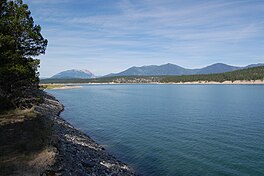| Lake Koocanusa | |
|---|---|
 | |
| Location | Montana / British Columbia |
| Coordinates | 48°55′N 115°11′W / 48.92°N 115.18°W |
| Lake type | reservoir |
| Primary inflows | Kootenay River (Canada) |
| Primary outflows | Kootenai River (USA) |
| Basin countries | United States, Canada |
| Surface elevation | 2,459 feet (750 m) |
Lake Koocanusa (KUU-KAN-USA) is a reservoir in British Columbia (Canada) and Montana (United States) formed by the damming of the Kootenai River by the Libby Dam in 1972. The Dam was formally dedicated by President Gerald Ford on August 24, 1975.[1]

The lake is formed north of the dam, reaching 48 miles (77 km) to the Canada–United States border and 42 miles (68 km) further into British Columbia. The lake holds 13% of the water in the Columbia River system. The town of Rexford was moved, as well as the Great Northern Railway line. The town of Waldo, British Columbia is now covered by the lake. What was once a barrier to river travel, Jennings Canyon is now inundated by the lake.[2] The Elk River joins the Kootenay River in the northern part of Lake Koocanusa, within Canadian territory.
Lake Koocanusa was named in a contest won by Alice Beers of Rexford, Montana.[1] The name is a portmanteau of Kootenai River, Canada, and USA.
Lake Koocanusa was built as a joint project of the U.S. and Canada. It is 26 km (16 mi) from Libby, Montana, also on the Kootenai River, from which the dam gets its name. Libby Dam has a Visitors Center and can be accessed by the Lake Koocanusa Scenic Byway which begins in the nearby town of Libby, Montana.
The Pacific Northwest National Scenic Trail follows Highway 37 along the east side of the lake before crossing over the Lake Koocanusa Bridge and climbing up Webb Mountain.
- ^ a b "Remarks at Dedication Ceremonies for the Libby Dam, Libby, Montana. | the American Presidency Project".
- ^ "Libby Dam - the Dams | Balance of Power". Archived from the original on 2011-06-29. Retrieved 2011-07-12.


